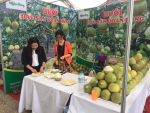
Binh Thuan Dragon Fruit
GEOGRAPHICAL AREA
The geographical area corresponding to the GI of Bình Thuận dragon fruit includes: districts of Ham Tan, Ham Thuan Nam, Ham Thuan Bac, Bac Binh and Phan Thiet city, Binh Thuan province.

HISTORICAL BACKGROUND AND REPUTATION
Dragon fruits which are native to arid tropical South America were migrated to Binh Thuan from the early 20th century. In the early period,
dragon fruit cactus were planted around the gardens as ornamental trees and the fruits were used as altar decorations and for ancestor
worships. Over time, favorable conditions of local soil and temperature (exhausted grey soil and sandy soil, high temperature, long light time)
have produced beautiful fruits and enriched the sweetness of dragon fruits grown in Binh Thuan.
Since the 1950s, dragon fruits have increasingly been used for eating and exported to many large markets such as China, Taiwan, America,
and Europe, etc. Dragon fruit has become the main crop of Binh Thuan province, reaching the growing area of 22,000 hectares (in 2017) with an annual output of 500,000 tons, and accounting for 70% of the dragon fruit growing area of Vietnam. Dragon fruit tree is a fasciculate root plant, taking
nutrients and water from the soil layer of 10 to 15cm only, suitable for the exhausted grey soil and sandy soil of Binh Thuan province. The dragon
fruit farming area, which is surrounded by high mountains to the west and is adjacent to the sea to the east, has high average temperature and high sunshine duration - the total accumulated thermal units are from 9,1000C to 9,7000C a year. These conditions are very suitable for the
growth of dragon fruit plants, which require high temperature and long lighting duration.
PRODUCT DESCRIPTION
Bình Thuận dragon fruit is of oblong shape – with a length of 1.4 - 1.6 times its diameter - and it has a thick peel, a skin of glossy red color at ripeness, thick and hard bracts and a large scale base. It weighs between 200 and 800g. The fruit pulp is firmly crispy, mildly sweet with a specific aroma and has few tiny seeds. Dragon fruit is rich in nutrients such as protein, iron, magnesium, calcium and vitamins, and its glucose content reaches 9.49g per 100g of fruit pulp.









